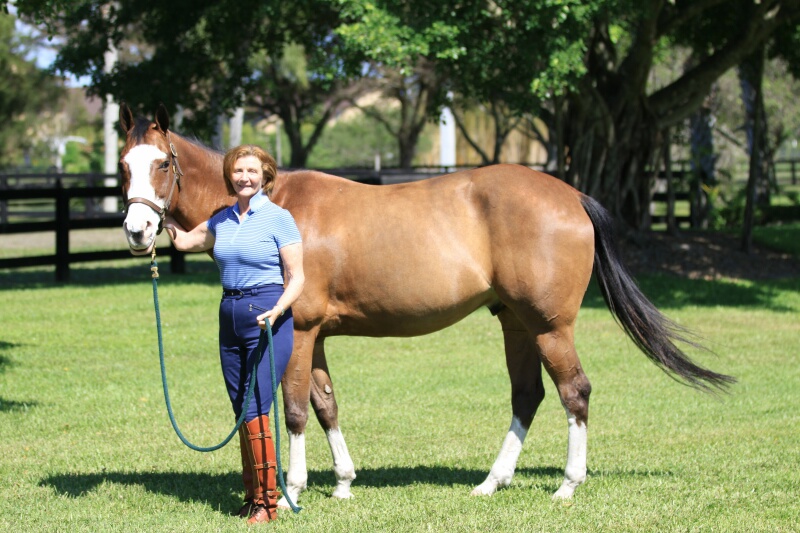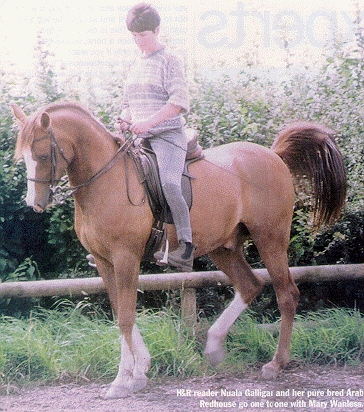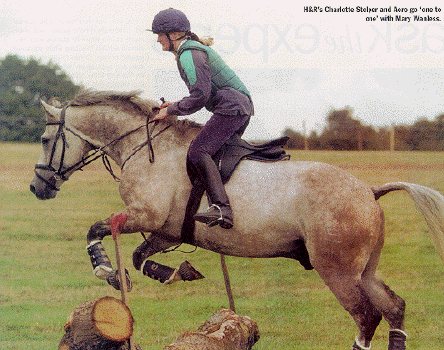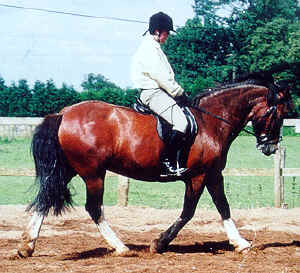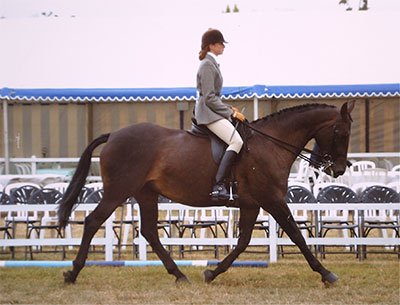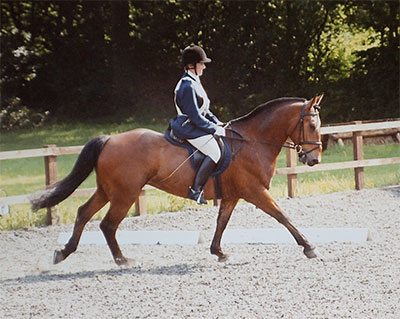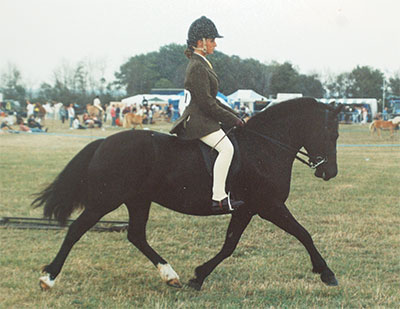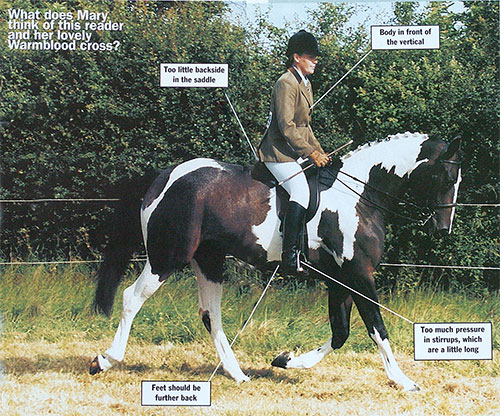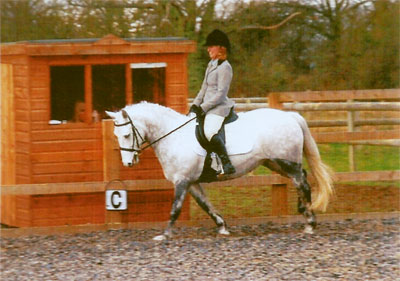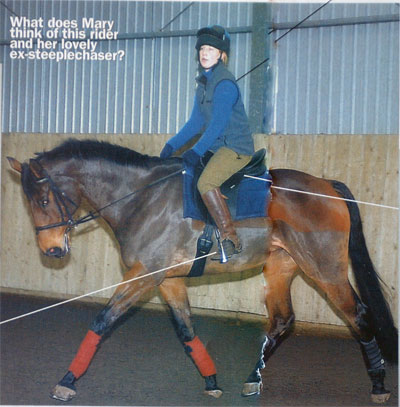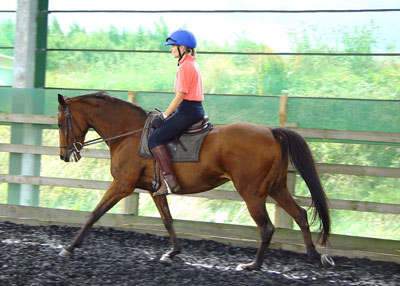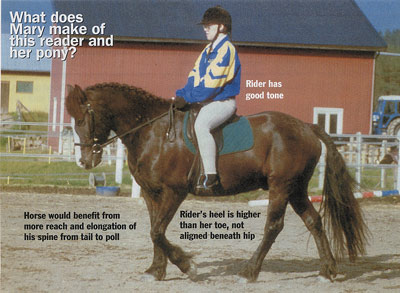RWYM
ARTICLE 23
 The photograph shows a 12 year old Selle Francais/TB mare. Meipe, her owner, bought her as a 6 year old, at which time she was in rather bad shape. A friend of Meipe’s has evented her, and she has won at both prenovice and novice level.
The photograph shows a 12 year old Selle Francais/TB mare. Meipe, her owner, bought her as a 6 year old, at which time she was in rather bad shape. A friend of Meipe’s has evented her, and she has won at both prenovice and novice level.
The photograph is taken in canter, with the diagonal pair of legs on the ground, and the inside fore foot about to land. Meipe is basically well organised, and would certainly land on the riding arena on her feet if we took her horse out from under her by magic. Thus she fulfills one of the important criteria of good rider biomechanics. However, this second beat of the canter stride is the easiest time for the rider to be in this balance; any rock of her shoulders will show up in the first beat of the stride (where they tend to rock forward) and third beat (where they tend to rock back). So the first and third beats are the most demanding in terms of the rider’s biomechanics and thus her stability.
There is a nice tonal quality to Meipe’s body – in other words, she looks solid, stable, and as if she has been ‘plonked’ onto the saddle. I remember one of my old teachers saying that the rider would look like a hunk of raw meat or putty that had been thrown onto the saddle from a point 45 degrees up and back behind it. In the next breath, however, he told me to relax. The basic problem was that I was already too much like jelly instead of putty, and attempting to relax more made my body even floppier. The muscle quality of good rider biomechanics can prove elusive – especially when teachers point you in totally the wrong direction as you search for it!
I see many many riders who need stability in their bodies, but who have been convinced that relaxation must be the answer. The confusion between relaxation and stabilisation is such that you might well look at Meipe and see a relaxed rider. I agree that she is not ‘uptight’, but do not agree with the assumption that the vast majority of riders would make themselves look like her by relaxing. On the contrary, to make yourself look like this, you would almost certainly have to hold your muscles more firmly. This misunderstanding about the quality of the body when demonstrating good rider biomechanics causes many ‘average’ riders a huge amount of grief.
My favourite analogy to describe muscle tone is that of a stuffed toy rider and horse. Meipe’s torso and thigh are that of a firmly stuffed stuffed toy, and it is this which tells us that her tone is high. As her calves continue down towards her ankle, however, she runs out of stuffing. Her upper arm hangs well, and is again full of stuffing, but there are some problems with the lower arm which we will come back to later.
Her horse is a fairly well stuffed toy horse. If you knew this horse you would know what a triumph this is, for she is an exceptionally long horse. Her back and neck can seem to go on forever, and when she is not ‘through’ she looks like a pantomime horse (the ultimate in unstuffedness)! Here, we see a lot of stuffing, but even though her nose is exactly on vertical, she is actually contracting her neck a little and ‘pushing back’ at the rider. Her neck will reach out of the wither even more when she is truly ‘through’ and the muscles on the underside of the neck let go more. The shape under her gullet will be more of an inverted ‘U’ than an inverted ‘V’.
In a badly ridden horse the ‘V’ can become much tighter than is it here. If the rider scrunches the horse backwards from the front – which is all too easily done – she encourages the neck to ‘push back’ towards her. When the hand becomes dominant, the horse is being ridden ‘from front to back’. Riding the horse ‘from back to front’, with a hand that offers no restrictions, requires tremendous stability in the rider’s torso. To sit well in the saddle, to appear not to move, to appear to do nothing, to seem as if you are saying ‘look, no hands’…. all of this demands that your torso stays ‘with’ the horse in each step. You are, in fact, matching the forces which the horse’s movement exerts on your body. This is no mean achievemet, and a cornerstone of good rider biomechanics.
For a practical understanding of the high muscle tone that this requires (and also the phrase ‘use your back’), try the following exercise. Ideally use a bath towel, but a sweatshirt or jacket that you can roll up will do equally well. Put the towel around your back under your armpits, and hold it keeping your shoulders and elbows down. Push back into it at the same time as you pull on it, being sure that you do not lean back or hollow your back. (If you use a bath towel and do the exercise in your bathroom, you can check this in a mirror.) Be sure to keep your shoulders and elbows down. Keep pulling on it for at least half a minute, then move it down a few inches and repeat. Gradually work your way down your back, until the towel is around your pelvis. Notice what happens to your abdominal muscles – you will be bearing down, using them in the way that skilled riders do (without knowing that they are doing so).
You can work up quite a sweat doing this exercise, and I am sure that it will not feel like relaxing or doing nothing. You are feeling the high tone of a ‘well stuffed’ rider, who can indeed say ‘look, no hands’. This is the optical illusion of good riding. Meipe has it well, although she could use some more push forward from the bottom part of her backside. Another part of the irony is that when the effort you are using is exactly matched to the task, it feels like doing nothing – hence the self-reports of good riders which become so misleading to average riders.
Meipe’s inside hand and lower leg are the least organised parts of her body. My hunch is that she is feeling her horse falling in on the corner, and has attempted to correct this by putting her heel against the horse, and by crossing her inside hand over the neck. Her outside hand is lower, and has turned over – a sure sign that the horse is not reaching into that rein in the way she would if Meipe had complete control of the path taken by her forelegs and shoulders.
I am pretty sure that Meipe’s central axis is vertical, and that she is not leaning in. This would compound her problems hugely. But she has reacted to her steering problem in the same way as the vast majority of riders, making a ‘sticking plaster’ correction that addresses the symptom and not the cause. The horse falls in and she, in effect, compensates for this by crossing her inside hand over the neck and putting the horse’s shoulders back out to the outside. Good rider biomechanics correct this problem much further back on the horse.
However, conventional thought implies that steering problems are corrected with the hands and lower legs. I believe that the most effective (and invisible) corrections happen within the rider’s torso, and also in her thighs. The problem has begun much further back on the horse than her shoulders, and during Meipe’s lessons at my centre, we addressed it through me asking her, ‘If we bisected your horse down the middle, would you be sitting on a symmetrical round thing? Would you have the same amount of horse under your left seat bone, left buttock and left thigh as you do under your right seat bone, right buttock and right thigh?’ Answering this question is not difficult, and it does not take enormous sensitivity to feel that there are differences on each side.
Meipe’s horse is falling to the left, and logic should tell you that there must be a bigger bulge on the left side of her rib cage. This displaces her centre of gravity to the left, which sends her shoulders to the left, and makes her put her neck and nose to the right to compensate. Most people think that you can use your lower leg to send the horse’s rib cage back over to the right, as Meipe has tried to do here. But in my experience, this does not work.
The fix has to happen much higher up on the rider’s body. It is under her seat bones, backside and top inside thigh that she has to ‘rearrange the rib cage’ (or ‘rearrange the stuffing’) to make it more symmetrical. Learning to do this is one of the more challenging aspects of rider biomechanics, but with skilled help it is well within the grasp of most riders. The most important starting point is realising what is really happening in the horse’s body and what you have to concentrate on to find the fix.
When you next ride, try asking yourself those questions about the symmetry of the surface you are sitting on. Work out how your horse organises his ribcage on each rein, and where his shoulders and head go in response to this. Then realise that the key issue is how to get more stuffing on the side where there is less stuffing, for (in Meipe’s case) this would reach the horse into the outside rein and stop her from falling inwards. If Meipe could make a flat shelf to sit on to the right of her right seat bone, filling out the horse where she tends to fall away, she would have solved her problem – without the need to compensate with her hand.

